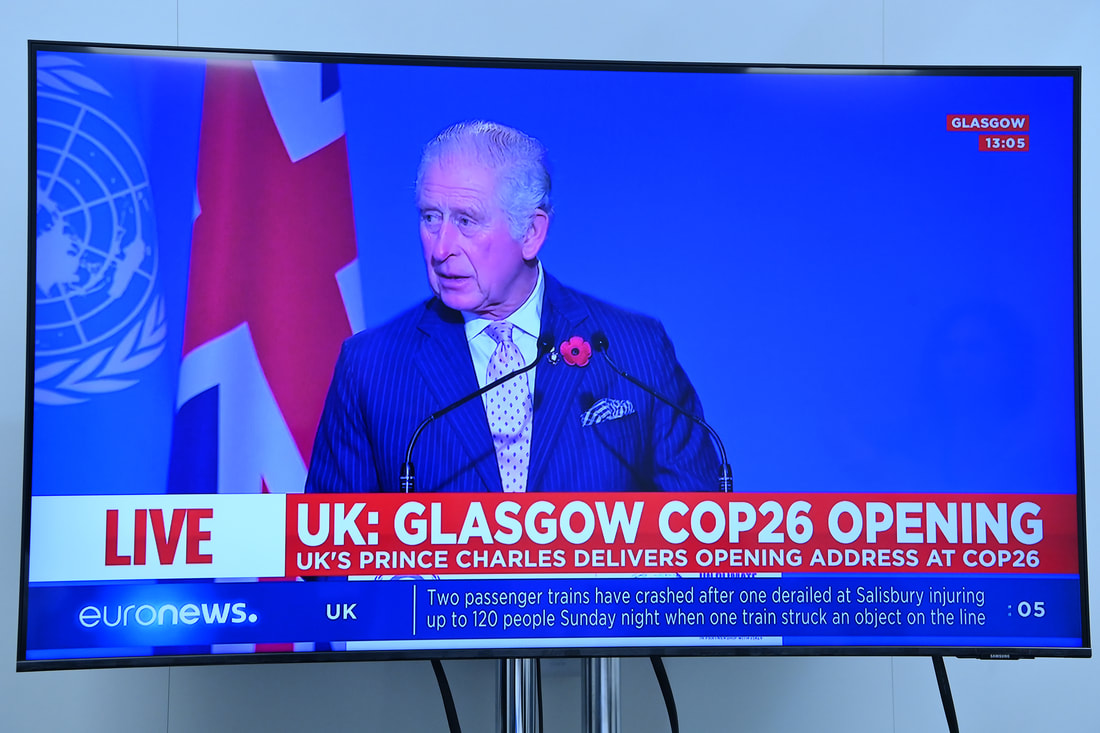|
By Allen Zhou '23 (Image Credit: IAEA Imagebank-COP26-https://commons.wikimedia.org/w/index.php?curid=112225031) In the past few weeks, Glasgow, Scotland has been abuzz with activity as the host of the United Nations Climate Conference (COP26). Even Greta Thunberg came on the scene without her father’s company for the first time to join the protestors jeering at the empty bluster. Every voice was louder than the last, but meaningful action seems ineffectual and distant in comparison to the urgency of the situation at hand. Aren’t we math-loving Martlets? Let's run some numbers first. The current global annual carbon dioxide emissions are 37 billion tons per year. To keep the increase of the Earth’s temperature within 1.5°C by 2100, global net emissions should be zero by 2050, and the carbon dioxide content in the atmosphere should be reduced by more than 10 billion tons every year thereafter. This dire situation has developed very rapidly compared to the time humans have been active on Earth. Before the Industrial Revolution in the early 19th century, the carbon dioxide content in the earth's atmosphere hovered between 185-275 ppm (parts per million). However, in the following 200 years, due to the extensive burning of fossil fuels, this has risen sharply and now exceeds 410 ppm. Since the greenhouse gas problem stems from technological progress, the solution must also depend on the technological revolution.
Recently, I heard about various solutions that claim to achieve zero emissions. The most interesting one is an advertisement I heard on the radio: "Using our credit card can help you offset your carbon emissions." After doing some research, the program appears to rely on planting trees to offset the carbon dioxide a person creates. However, after careful calculation, this scheme is far too minimal in terms of real impact. Every year a tree can absorb approximately 22 kilograms of carbon dioxide, every acre of forest can absorb about 2.5 tons. To absorb 370 billion tons of carbon dioxide, there need to be 148 billion acres more forest. Taking into account that the total land surface area of Earth is only around 370 billion acres and that almost a third of that land is already being forested, there simply is not enough land to plant all of these trees. This is not even beginning to consider how much of said land is unviable for vegetation, with vast areas such as Siberia and Antarctica being completely unfit for such a plan. Clearly, just planting more trees is not going to be enough. What about the trendy Elon Musk electric vehicles — can a widespread adoption of those help us achieve zero emissions? First, we must examine how much transportation impacts the planet. Transportation includes aviation, land and sea, which together account for 10% of carbon emissions. Even if every person on Earth began using Tesla electric vehicles, and all-electric vehicles are powered by renewable energy such as solar and wind power, we can only reduce emissions by 3 billion tons per year. Also taking into consideration that carbon emissions are caused by the production of batteries and vehicles, electric vehicles alone can only help us solve a small part of a far bigger problem. Next, let us take a closer look at one of the supposedly important achievements of COP26. One hundred countries have pledged to reduce methane emissions by 30% by 2030, which is equivalent to 130-230 million tons reduction per year. This figure pales in comparison to the annual total emission of 37 billion tons, which makes the impact of this commitment seem very limited. Fortunately, because methane is a much more potent greenhouse gas than CO2, if these nations deliver on their promises, the effect will be comparable to everyone driving an electric car every day. It is apparent that even if we immediately achieve zero emissions, our climate will continue to warm because the current concentration of greenhouse gases in the atmosphere is too high. The only way to keep the temperature stable is evidently to rapidly lower the concentrations of greenhouse gas in the atmosphere. In other words, zero-emissions are far from enough, and "negative emissions" are needed. Luckily, great strides have already been made in developing a solution to scrubbing CO2 from the atmosphere. In Iceland, not far from Scotland, scientists at CarbFix discovered that carbon dioxide can be dissolved into water and injected into the areas rich with basalt deep underground. After a few years, these carbonated water-infused volcanic rocks will become crystal clear stones called Iceland Spar, locking CO2 inside permanently. This process scrubs carbon dioxide from the atmosphere and turns it into a solid and stores it underground, thereby reducing the greenhouse effect. Iceland is a volcanic island, so basalt is incredibly plentiful, which is why this method is very suitable for the region. Although only 13,000 tons of carbon dioxide can be extracted per year, it is estimated that it can be increased to 1 million tons per year in the next 10 years. Moreover, there are many places with similar crustal compositions in the world. If 200 facilities of a similar scale are established, they can certainly make a meaningful dent in the atmospheric greenhouse gas concentration. Knowing that basalt is still a relatively limited resource, is there another more abundant resource able to lock in CO2? A potential answer lies in seawater. The ocean acts as the biggest carbon sink on earth, but it’s already quite saturated making it necessary to separate CO2 from seawater and lock it into a solid to extract this excess CO2. At the forefront of parsing out this issue are researchers from the School of Engineering at UCLA. According to a paper published earlier this year, they have created electrode devices in the laboratory that cause the dissolved CO2 in the seawater to combine with calcium and magnesium ions to form a solid CaCO3 or MgCO3, thereby locking away the CO2 permanently. The researchers calculated that the calcium and magnesium ions in the ocean are more than sufficient to combine all the carbon dioxide that needs to be solidified, making this solution applicable on a global scale. In addition to the hardware equipment, the only additional requirement for this process is electricity. About 2300 kilowatt-hours (KWh) of electricity is needed to solidify each ton of carbon dioxide. If 10 billion tons of carbon dioxide need to be solidified every year, it will consume 23 trillion-watt-hours (TWh) of electricity. This number is quite vexing, as the current global annual electricity generation is only about 25 TWh. The current global renewable energy power generation capacity is already 2.8 gigawatts. If they are running at 80% capacity 50% of the time, they can generate about 10 TWh of electricity per year. We need only to double the installed capacity, double their uptime, or improve their efficiency, and we will have enough electricity to run these “mineralization” machines. In addition, this method will be optimized in the future, which will greatly reduce power consumption. Also, the best part is that the by-product of this method is hydrogen, which can be used as an energy source in other fields. Therefore, this method may be one of the effective ways to quickly resolve greenhouse gases. Let us wait and see. As usual, COP26 was an ebullient show of political posturing and weak answers to burning questions, but it did accomplish one very important thing: it brought even more attention to a pressing crisis. With our resources and intelligence pooled, breakthroughs and innovation will soon follow. Comments are closed.
|
Photos from Verde River, Manu_H, focusonmore.com, Brett Spangler, Cloud Income

